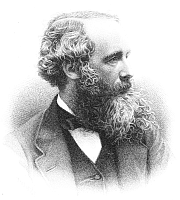 |
Maxwell's Reciprocal Theorem | Maxwell Legacy Concepts |
|---|
In a nutshell |
Maxwell's reciprocal theorem, sometimes called Maxwell's reciprocal rule, is a technical relationship that equates two separate distortions in an elastic structure under load. It can either be used to reduce the number of factors calculated in a given circumstance or used as a check that the calculation has correctly predicted the equality of two separate distortions. Maxwell's rule is one of the basic tools of structural engineering. A simple example of the general rule is illustrated in the diagram on the right. A beam is supported near either end. A unit load is applied in the centre (for simplicity as an example), at point C. The beam is not just deflected at the centre but all along its length. Let the deflection at a point D be δDC. Maxwell's reciprocal theorem says that the deflection at D due to a unit load at C is the same as the deflection at C if a unit load were applied at D. In our notation, δCD = δDC. The lower diagram illustrates the second situation. |
|---|
| Technical detail | Maxwell's reciprocal theorem doesn't just apply to beams but to any linear elastic body, including surfaces. It doesn't just apply to displacements but also to rotations produced by torques. It is derived relatively straightforwardly by examining the work done when two different forces are applied. If a force F is applied against an elastic resistance, Hooke's law says that the force of resistance increases linearly until it balances the applied force. Suppose the final displacement is x. The work done against the increasing resistance is ½Fx. On the other hand, if a force is moved a distance y, then the work done is Fy. There is a further assumption that the distortion applied by a given force at a given point is independent of the existence of other loads. These basics are applied on the right to the situation of loads being applied in succession, first at C and then at D, and then in the reverse order. With a linear elastic system undergoing small distortions, the net result will not depend on the order in which the two loads are applied. The argument on the right has been given for 'unit load' but any load can be taken under the assumptions. JSR 2016 |
|---|